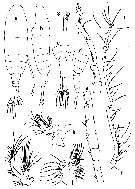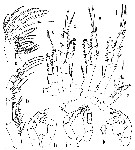|
|
 |
|
Calanoida ( Order ) |
|
|
|
Diaptomoidea ( Superfamily ) |
|
|
|
Centropagidae ( Family ) |
|
|
|
Sinocalanus ( Genus ) |
|
|
| |
Sinocalanus doerrii (Brehm, 1909) (F,M) | |
| | | | | | | Ref.: | | | Orsi & al., 1983 (p.358, figs.F,M) |  issued from : J.J. Orsi, T.E. Bowman, D.C. Marelli & A. Hutchinson in J. Plankton Res., 1983, 5 (3). [p.360, Fig.1]. Female (from California's Sacramento-San Joaquin estuary, San Francisco): a-b, habitus (dorsal and lateral, respectively); g, A1 (segment 24); h, A1 (segments 1-14; i, A1 (segments 15-24); J, A2; k, Md; l, Mx1. Male: c-d, posterior pedigers and urosome (dorsal and lateral, respectively); e, right A1 (segments 10-17); f, A1 (segments 17-24).
|
 issued from : J.J. Orsi, T.E. Bowman, D.C. Marelli & A. Hutchinson in J. Plankton Res., 1983, 5 (3). [p.361, Fig.2] Female: a, Mx2; b, Mxp; c, P1; d, P2; e, P3; f, P4; g, P5. Male: h, P5 (anterior); i, idem (posterior); j, distal segment of right P5 (posterior; k, P5 (posterior; from different specimen).
|
 issued from : W. Zhang, N. Zhao, Z. Tao & C. Zhang in An Illustrated Guide to Marine Planktonic Copepods in China Seas, Science Press, Beijing. [p.454, Fig.512]. As Sinocalanus dorrii. Male: right P5.
| | | | | Compl. Ref.: | | | Cordell & al., 1997 (p.2, 7, invasive form, % change 1980-1997); Ohtsuka & al., 2008 (p.115, Table 6); Gao X. & al., 2011 (p.591, p.597: occurrence); Bollens & al., 2011 (p.1358, Table III, fig.8); Bollens & al., 2012 (p.101, fig.2, Table 1, species competition) | | | | NZ: | 2 | | |
|
Distribution map of Sinocalanus doerrii by geographical zones
|
| | | | | |  Issued from : M. Winder, A.D. Jassby & R.M. Nally in Ecology Letters, 2011, 14. [p.753, Fig.3, a]. Issued from : M. Winder, A.D. Jassby & R.M. Nally in Ecology Letters, 2011, 14. [p.753, Fig.3, a].
Historical abundances of introduced species in the upper San Francisco Estuary between 1972 and 2009.
Adult stages are shown because immature stages were not continuously identified. |
| | | | Loc: | | | China Seas (East China Sea, Changjiang River estuary, South China Sea, in W. Zhang & al., 2010) as dorrii), San Francisco Estuary, California (estuaries) | | | | N: | 5 | | | | Lg.: | | | (1054) F: 1,44-1,73; M: 1,30-1,69; {F: 1,44-1,73; M: 1,30-1,69} | | | | Rem.: | Freshwater and brackish. Incomplete data.
For Orsi & al. (1983, p.357) this species native of the rivers of mainland China was found in 1978 in California's Sacramento-San Joaquin Estuary, abundant and may be regarded as well established. The introduction occurred a relatively short time. The most probable mode of introduction in ballast water from Japanese freighters previously docking in China, which discharge into San Francisco Bay. | | | Last update : 03/03/2016 | |
|
|
 Any use of this site for a publication will be mentioned with the following reference : Any use of this site for a publication will be mentioned with the following reference :
Razouls C., Desreumaux N., Kouwenberg J. and de Bovée F., 2005-2024. - Biodiversity of Marine Planktonic Copepods (morphology, geographical distribution and biological data). Sorbonne University, CNRS. Available at http://copepodes.obs-banyuls.fr/en [Accessed April 24, 2024] © copyright 2005-2024 Sorbonne University, CNRS
|
|
 |
 |







